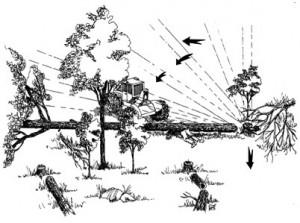BACKGROUND: A logger was working alone on level ground in a Northeast hardwood stand. It was a cool, overcast day in the fall. A steady breeze was blowing.
PERSONAL CHARACTERISTICS: The logger had 20 years’ experience and was considered a safe worker. He had attended the state’s logger training program. He was wearing all the required personal protective equipment for tree felling.
UNSAFE ACT OR CONDITIONS: After cutting a 45-degree notch in an 18-inch maple, the logger began making a backcut but pinched his chain saw in the cut. The wind conditions may have contributed.
ACCIDENT: After attempting to break the hinge of the tree by winching it with the skidder, the logger tried to pull the saw out of the backcut. It appears that after his unsuccessful attempt to remove the chain saw, he began walking back to the skidder. The hinge of the setback tree broke and struck the logger in the back, pinning him to the ground.
INJURIES: The logger died of internal injuries.
RECOMMENDATIONS FOR CORRECTION: To ensure consistent application, the logger or the contractor should continually evaluate directional felling techniques. A larger notch (open-faced felling calls for a 70- to 90-degree notch) and the placement of wedges might have averted the pinching of the saw bar.
Additional circumstances that contributed to the feller’s death include:
- The position of the skidder did not allow for pushing over the tree.
- The logger failed to keep the hazard tree in view at all times while in the hazard zone.
- The recommended hinge was compromised by recurrent bypass of notch cuts.
Periodic self-evaluation or review by the crew supervisor will identify the necessary adjustments to the felling system and avoid this type of injury exposure.
 Courtesy of the Forest Resources Association: https://www.forestresources.org/
Courtesy of the Forest Resources Association: https://www.forestresources.org/
